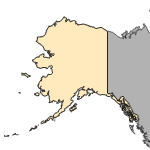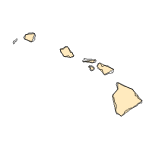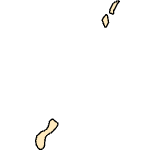Xiphophorus hellerii × maculatus
(red swordtail)
Fishes
Exotic Hybrid |
|
Common name: red swordtail
Synonyms and Other Names: green swordtail x southern platyfish (red swordtail x southern platyfish).
Identification: For information on hybridization between these species and their offspring see Gordon and Rosen (1951), Gordon and Gordon (1957), and Atz (1962). Distinguishing characteristics of the parent species were given by Rosen (1960, 1979) and Page and Burr (1991).
Size: Similar to parental species
Native Range: Not applicable.



|

Alaska |

Hawaii |

Puerto Rico &
Virgin Islands |

Guam Saipan |
Hydrologic Unit Codes (HUCs) Explained
Interactive maps: Point Distribution Maps
Nonindigenous Occurrences:
This hybrid combination has been recorded from Brevard and Hillsborough counties in Florida (Courtenay et al. 1974), both counties having many commercial ornamental fish farms at that time.
Table 1. States with nonindigenous occurrences, the earliest and latest observations in each state, and the tally and names of HUCs with observations†. Names and dates are hyperlinked to their relevant specimen records. The list of references for all nonindigenous occurrences of Xiphophorus hellerii × maculatus are found here.
Table last updated 12/11/2025
† Populations may not be currently present.
Ecology: Similar to parental species.
Means of Introduction: Most likely introduced through aquarium releases or fish farm escapes or releases.
Status: Unlikely to be established in Florida. Shafland et al. (2008) do not list it as permanently established in the state.
Impact of Introduction: The impacts of this species are currently unknown, as no studies have been done to determine how it has affected ecosystems in the invaded range. The absence of data does not equate to lack of effects. It does, however, mean that research is required to evaluate effects before conclusions can be made.
References: (click for full references)
Atz, J.W. 1962. Effects of hybridization on pigmentation in fishes of the genus
Xiphophorus. Zoologica 47:153-181.
Courtenay, W.R., Jr., and J.E. Deacon. 1982. Status of introduced fishes in certain spring systems in southern Nevada. Great Basin Naturalist 42(3):361-366.
Courtenay, W.R., Jr., H.F. Sahlman, W.W. Miley, II, and D.J. Herrema. 1974. Exotic fishes in fresh and brackish waters of Florida. Biological Conservation 6(4):292-302.
Deacon, J.E., and J.E. Williams. 1984. Annotated list of the fishes of Nevada. Proceedings of the Biological Society of Washington 97(1):103-118.
Gordon, H., and M. Gordon. 1957. Maintenance of polymorphism by potentially injurious genes in eight natural populations of the platyfish, Xiphophorus maculatus. Journal of Genetics 55(1):1-44.
Gordon, M., and D.E. Rosen. 1951. Genetics of species differences in the morphology of the male genitaliaof xiphophorin fishes. Bulletin of the American Museum of Natural History 95(7):415-464.
Page, L.M., and B.M. Burr. 1991. A field guide to freshwater fishes of North America north of Mexico. The Peterson Field Guide Series, volume 42. Houghton Mifflin Company, Boston, MA.
Rosen, D.E. 1960. Middle-American poeciliid fishes of the genus Xiphophorus. Bulletin of the Florida State Museum Biological Sciences 5(4):57-242.
Rosen, D.E. 1979. Fishes from the uplands and intermontane basins of Guatemala: revisionary studies and comparative geography. Bulletin of the American Museum of Natural History 162:267-376.
Shafland, P.L., K.B. Gestring, and M.S. Stanford. 2008. Florida's Exotic Freshwater Fishes - 2007. Florida Scientist 71(3):220-245.
Other Resources:
Fact Sheet for Xiphophorus hellerii - USGS Nonindigenous Aquatic Species Database
Fact Sheet for Xiphophorus maculatus - USGS Nonindigenous Aquatic Species Database
Author:
Leo Nico,Pam Fuller, and Bill Loftus
Revision Date: 5/9/2019
Peer Review Date: 9/17/2012
Citation Information:
Leo Nico,Pam Fuller, and Bill Loftus, 2025, Xiphophorus hellerii × maculatus: U.S. Geological Survey, Nonindigenous Aquatic Species Database, Gainesville, FL, https://nas.er.usgs.gov/queries/FactSheet.aspx?SpeciesID=870, Revision Date: 5/9/2019, Peer Review Date: 9/17/2012, Access Date: 12/11/2025
This information is preliminary or provisional and is subject to revision. It is being provided to meet the need for timely best science. The information has not received final approval by the U.S. Geological Survey (USGS) and is provided on the condition that neither the USGS nor the U.S. Government shall be held liable for any damages resulting from the authorized or unauthorized use of the information.